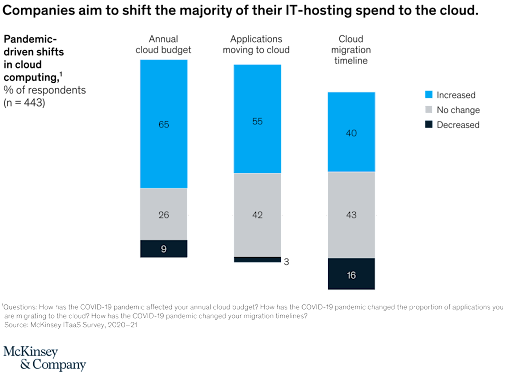In today’s data-driven world, businesses are constantly seeking ways to optimize their operations, improve decision-making and drive innovation. Moving your data warehouse to the cloud is an essential step in accomplishing these objectives. Compared to conventional on-premises systems, cloud-based data warehousing has many benefits that help businesses make the most of their data while cutting costs and boosting agility. As per McKinsey, Businesses that follow the best practices of successful cloud migration stand to unlock almost $1 trillion in value.

What to Explore
The top five business factors that will make moving your data warehouse to the cloud a wise decision in 2023 will be discussed in this blog post.
1. Scalability and Flexibility:
Scalability is one of the main advantages of migrating your data warehouse to the cloud. With the use of a data warehouse, your company may simply scale up or down its IT needs as needed. For long-term success, businesses are experimenting with a variety of data modeling techniques. Cloud computing once again proves its mettle by being able to grow on demand and adapt to changing requirements because there is no one size fits all answer. Data warehouse modernization offers businesses an infrastructure that meets the purpose as and when necessary without integrating or optimizing difficulties thanks to autonomous scaling or de-scaling of servers, storage, and network bandwidth to manage massive volumes with unprecedented efficiency.
2. Cost-effectiveness:
Moving your data warehouse to the cloud has several compelling commercial reasons, including cost-effectiveness. On-site data warehouses demand hefty initial outlay for technology, software licenses, and ongoing maintenance expenses. In contrast, pay-as-you-go cloud-based data warehousing enables organizations to match expenditures with real consumption. Utilizing the cloud minimizes the risk of underutilized resources, lowers maintenance costs, and eliminates the need to purchase hardware. Further cost optimization is possible because of the variety of price choices provided by cloud providers, including reserved instances and spot instances. You can drastically lower the total cost of ownership while having access to cutting-edge analytics capabilities by moving to the cloud.
3. Design for the present and the future needs:
Using technology to pursue growth and innovation is a great facilitator and accelerator. This includes remaining on top of developments and streamlining all procedures to ensure their dependability. Take into account the benefits of zero-code ETL tools, self-service BI, and DW automation platforms as well as the rate of change in each of these areas. You can confidently satisfy new business requirements at speed and scale because of these cutting-edge platforms and solutions.
4. AI and Advanced Analytics:
In the era of data-driven decision-making, organizations are increasingly depending on AI and advanced analytics to gather insightful data and spur innovation. Platforms for cloud-based data warehousing offer a solid framework for putting sophisticated analytics solutions in place. You may harness the power of predictive and prescriptive analytics to find hidden trends, spot anomalies, and generate data-driven predictions by integrating seamlessly with other cloud services, such as machine learning and AI platforms. Businesses may experiment with various analytics methods and easily scale their infrastructure to meet the rising needs of AI workloads thanks to the flexibility and scalability of the cloud.
5. Data Security and Compliance:
Businesses have always been very concerned about data security and compliance, especially when dealing with sensitive consumer data and legal requirements. The security capabilities of traditional on-premises solutions are frequently surpassed by cloud providers, who make significant investments in installing strong security measures and adhering to industry best practices. You may take advantage of cutting-edge security features like encryption, data masking, identity, and access control, and continuous monitoring by moving your data warehouse to the cloud. To ensure compliance with local and industry rules, cloud providers also go through frequent audits and maintain certifications. You can improve data security and more successfully meet compliance standards by committing your data to a reliable cloud provider.
Conclusion:
In 2023, moving your data warehouse to the cloud will offer a variety of business benefits that will transform your company’s data capabilities. The cloud offers a complete solution to unlock the full potential of your data assets, from scalability and cost-effectiveness to improved performance, advanced analytics, and strong security. Businesses may maintain their agility, take quicker, data-driven choices, and gain new insights for innovation and expansion by using the cloud. To maximize the benefits and overcome any potential obstacles, make sure the migration is well-planned and executed with a smooth transition process.
Getting Started
While the benefits are numerous, and the technology matures, there can be many pitfalls on the path to migrating your data warehouse to a cloud environment. Understanding which platform and strategy can best help you achieve your business goals is a crucial first step. An experienced solutions provider should be able to help you conduct your cloud strategy and assessment to develop an implementation roadmap.
You Might Also Like

Data Security
Implementing Fine-Grained Data Access Control: A Complete Guide to GCP Column-Level Policy Tags
Learn More










